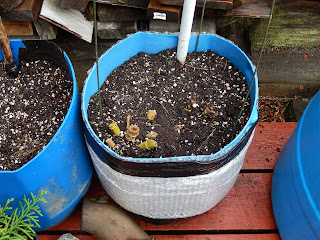 |
| Step 1: Insulate the Dahlia container in bubble wrap. |
The tubers were hard to dig, and needed added moisture in their protective sacks ever few weeks. But, most of them did survive for replanting.
Last fall I tried something different. I wrapped my dahlia containers with bubble wrap and covered the soil with a heavy mulch.
In summer, the dahlias gave me lush plants and beautiful flowers. I would call that a huge success with very little effort.
 |
| Step 2: Cut the Dahlias back in fall. |
We don't get extreme cold, but do have several stretches of freezing weather.
I left the bubble wrap on the pots, so that step was already done.
Click here to read more about it. Save the small sized bubble wrap from parcel packaging. You'll have a free supply for winterizing projects.
 |
| Step 3: Cover the soil with crumpled newspaper. |
When the weather started turning cold and the foliage died, I cut the dahlia plants back to an inch above the soil level.
I crumpled newspaper over the soil to give the tubers an insulation barrier.
 |
| Step 4: Cover the newspaper with a piece of cardboard. |
This has been a good alternative for me, and I've successfully winterized my rhubarb the same way since 2010.
 |
| Step 5: Cover the cardboard with soil to hold everything in place. |
Have you ever kept dahlias outdoors through the winter? Do you get freezing nights? Was it successful for you? -- Margy















